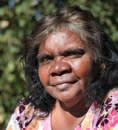Margaret Mungulu Australian, Worrorra, b. 1955
Margaret first started painting in 1967 and was taught by her father. As a child she would love to carve boab nuts and emu eggs with copper wire.
“You know how kids work, I was taught to use a knife but I used copper first because the eggs would bust. I was about seven years old, then. I would draw emus, goannas, snakes until my hands got used to wire. All the old men used to do carvings outside their houses. We would pass by them on our way to other countries. We watched them and one day we wanted to be in that situation, carving and painting.”
Margaret was schooled in Derby and completed three years of high school studies. “When we were all sitting around the house I was told, you make a decision for yourself. You make a choice. My father was paralysed so we need to push him around and help him. He said you look after my needs, now you need to look after other’s needs. Nursing would be a good one. Try and get a job in the welfare.” Edna, my sister, and I did nurses’ training. “
While working at the hospital Margaret would talk to the old people (patients) about cultural law and traditions before they passed away. When Margaret started painting at the Mowanjum Hall, she used to sit next to the old people and ask questions about the Wandjina, “was it real - what was it.”
Margaret has visited most cave sites along the Gibb River Road. She adds, “David Mungulu, my dad’s uncle would say, ‘I want you to connect with the Wandjina. It is like dreaming and we need to dream. The Wandjina is leader of our tribe’. We stopped painting a couple of times because of arguments with other tribes but we were told, ‘don’t worry about anything. Keep our people strong, keep the Wandjina happy, repaint them and keep them fresh’.”
Margaret’s great grandfather was from Wunumbul, her mother was from Ngarinyin and father was from Worrorra. Margaret’s family connections were from all three tribes that make up the Monwanjum community. Margaret says, “We were kept together through the stories of my grandfather and father. We were told stories before books were made. We say you kids are spiritual kids born through “Wudu” (the laws of living).”
Margaret advises that, “When a larger art centre was being considered by the community, art was made and put aside.” A decision was made by the community to propose a design for the art centre that would be the shape of the Wandjina. Led byDonny Woolagoodja, the proposition “relied on us to build something, not just for our generation but for generations to come. We went to Derby and asked for help. We made drawings and asked for the roof to look like the Wandjina and for paintings to be shown there.” Today Margaret “can walk in this building and paint.”
The painting experience for Margaret begins with, “something pops into my head, that picture tells a story in my mind. It’s imagination you know. I walk around and wait for the image to come into my head.” She adds, “As a toddler, old men at the old site, would bring me paper bark and paint for me with ochre, I used to practice how to draw animals. I was so spoilt by them.”
Margaret has exhibited in Sydney, Melbourne, Perth, Derby and internationally in Slovenia. She belongs to the Mungulu dynasty of painters.
